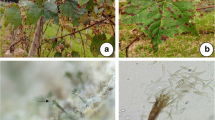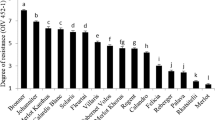Abstract
Viticulture in Europe and other parts of the world is continuously suffering significant economic loss from downy mildew epidemics. Although the infection biology of the pathogen Plasmopara viticola is well understood, little is known on the population diversity of this oomycete and on the mechanisms responsible for compatible or incompatible reactions with different host genotypes. The discrimination of strains with different virulence is a fundamental step for the assessment of pathotypes in local populations and could help to develop measures for preventing economic loss. We here describe an extended and slightly modified bioassay for the assessment of virulence by means of sporulation intensity. Simultaneously the necrotic reaction of host genotypes is considered and allows identification of different resistance strategies. Comparison of infections symptoms of 12 host genotypes after inoculation with five different single sporangium strains of Plasmopara viticola showed that: 1. resistance diversity is high in some Vitis vinifera cultivars; 2. Vitis riparia showed the strongest resistance amongst the four tested North American species; and 3. Asian Vitaceae harbor fully resistant as well as highly susceptible genotypes. In addition, microscopic investigation of inoculated leaf discs from Vitis amurensis and Ampelopsis japonica unraveled, that despite lack of sporulation vital pathogen mycelium was observed in the intercellular system. The necrotic reaction in V. amurensis indicates a different mechanism of resistance when compared to A. japonica, where no necrosis was found.




Similar content being viewed by others
References
Alonso-Villaverde, V., Voinesco, F., Viret, O., Spring, J. L., & Gindro, K. (2011). The effectiveness of stilbenes in resistant Vitaceae: ultrastructural and biochemical events during Plasmopara viticola infection process. Plant Physiology and Biochemistry, 49(3), 265–274. doi:10.1016/j.plaphy.2010.12.010.
Arnold, C., Schnitzler, A., Douard, A., Peter, R., & Gillet, F. (2005). Is there a future for wild grapevine Vitis vinifera subsp. silvestris in the Rhine Valley. Biodiversity and Conservation, 14(6), 1507–1523. doi:10.1007/s10531-004-9789-9.
Bellin, D., Peressotti, E., Merdinoglu, D., Wiedemann-Merdinoglu, S., Adam-Blondon, A. F., Cipriani, G., et al. (2009). Resistance to Plasmopara viticola in grapevine “Bianca” is controlled by a major dominant gene causing localised necrosis at the infection site. Theoretical and Applied Genetics, 120(1), 163–176. doi:10.1007/s00122-009-1167-2.
Blasi, P., Blanc, S., Wiedemann-Merdinoglu, S., Prado, E., Rühl, E. H., Mestre, P., & Merdinoglu, D. (2011). Construction of a reference linkage map of Vitis amurensis and genetic mapping of Rpv8, a locus conferring resistance to grapevine downy mildew. Theoretical and Applied Genetics, 123(1), 43–53. doi:10.1007/s00122-011-1565-0.
Boso, S., & Kassemeyer, H. (2008). Different susceptibility of European grapevine cultivars for downy mildew. Vitis, 47(1), 39–49.
Boso, S., Alonso-Villaverde, V., Gago, P., Santiago, J. L., & Martínez, M. C. (2011). Susceptibility of 44 grapevine (Vitis vinifera L.) varieties to downy mildew in the field. Australian Journal of Grape and Wine Research, 17(3), 394–400. doi:10.1111/j.1755-0238.2011.00157.x.
Cadle-Davidson, L. (2008). Variation within and between Vitis spp. for foliar resistance to the downy mildew pathogen Plasmopara viticola. Plant Disease, 92(11), 1577–1584. doi:10.1094/PDIS-92-11-1577.
Casagrande, K., Falginella, L., Castellarin, S. D., Testolin, R., & Di Gaspero, G. (2011). Defence responses in Rpv3-dependent resistance to grapevine downy mildew. Planta, 234(6), 1097–1109. doi:10.1007/s00425-011-1461-5.
Denzer, H., Staudt, G., & Schlösser, E. (1995). Wirtsbesiedlung durch Plasmopara viticola bei unterschiedlich anfalligen Wirten. Vitis, 34(1), 45–49.
Díez-Navajas, A., Wiedemann-Merdinoglu, S., Greif, C., & Merdinoglu, D. (2008). Nonhost versus host resistance to the grapevine downy mildew, Plasmopara viticola, studied at the tissue level. Phytopathology, 98(7), 776–780. doi:10.1094/PHYTO-98-7-0776.
Fischer, B. M., Salakhutdinov, I., Akkurt, M., Eibach, R., Edwards, K. J., Töpfer, R., & Zyprian, E. (2004). Quantitative trait locus analysis of fungal disease resistance factors on a molecular map of grapevine. Theoretical and Applied Genetics, 108(3), 501–515. doi:10.1007/s00122-003-1445-3.
Gindro, K., Pezet, R., & Viret, O. (2003). Histological study of the responses of two Vitis vinifera cultivars (resistant and susceptible) to Plasmopara viticola infections. Plant Physiology and Biochemistry, 41(9), 846–853. doi:10.1016/S0981-9428(03)00124-4.
Gobbin, D., Pertot, I., & Gessler, C. (2003). Identification of microsatellite markers for Plasmopara viticola and establishment of high throughput method for SSR analysis. European Journal of Plant Pathology, 109(2), 153–164. doi:10.1023/A:1022565405974.
Gobbin, D., Rumbou, A., Linde, C. C., & Gessler, C. (2006). Population genetic structure of Plasmopara viticola after 125 years of colonization in European vineyards. Molecular Plant Pathology, 7(6), 519–531. doi:10.1111/j.1364-3703.2006.00357.x.
Gómez-Zeledón, J., Zipper, R., & Spring, O. (2013). Assessment of phenotypic diversity of Plasmopara viticola on Vitis genotypes with different resistance. Crop Protection, 54, 221–228. doi:10.1016/j.cropro.2013.08.015.
Gómez-Zeledón, J., Becker, S., & Spring, O. (2014). Analysis of putative effectors in grapevine downy mildew strains of different virulence. In A. M. Díez-Navajas, A. Ortiz-Barredo, C. Menéndez, R. Emmett, D. Gadoury, W. D. Gubler, et al. (Eds.), 7th international workshop on grapevine downy and powdery mildew (pp. 142–143). Vitoria/Gasteiz: Arabako Foru Aldundia.
Gómez-Zeledón, J., Kaiser, M., & Spring, O. (2015). Effector gene expression in Plasmopara viticola strains with different virulence against a tolerant host. In J. Brook (Ed.), 36th New Phytologist Symposium/Cell biology at the plant-microbe interface (p. 43). Munich.
Jürges, G., Kassemeyer, H., & Dürrenberger, M. (2009). The mode of interaction between Vitis and Plasmopara viticola Berk. & Curt. Ex de Bary depends on the host species. Plant Biology, 11, 886–898. doi:10.1111/j.1438-8677.2008.00182.x.
Kamoun, S., Furzer, O., Jones, J. D. G., Judelson, H. S., Ali, G. U. L. S., Dalio, R. J. D., et al. (2015). The top 10 oomycete pathogens in molecular plant pathology. Molecular Plant Pathology, 16(4), 413–434. doi:10.1111/mpp.12190.
Kast, W. (2001). Inter-isolate variation of virulence of Plasmopara viticola on resistant vine varieties. In IOBC / WPRS Working Group „Integrated Control in Viticulture“ (Vol. 24, pp. 45–49).
Kiefer, B., Riemann, M., Büche, C., Kassemeyer, H. H., & Nick, P. (2002). The host guides morphogenesis and stomatal targeting in the grapevine pathogen Plasmopara viticola. Planta, 215(3), 387–393. doi:10.1007/s00425-002-0760-2.
Kortekamp, A., & Zyprian, E. (1999). Leaf hairs as a basic protective barrier against downy mildew of grape. Journal of Phytopathology, 147, 453–459.
Kortekamp, A., Wind, R., & Zyprian, E. (1998). Investigation of the interaction of Plasmopara viticola with susceptible and resistant grapevine cultivars. Journal of Plant Diseases and Protection, 105(5), 475–488.
Lalancette, N., Ellis, M., & Madden, L. (1988). Development of an infection efficiency model for Plasmopara viticola on American grape based on temperature and duration of leaf wetness. Phytopathology, 78, 794–800.
Li, X., Wu, J., Yin, L., Zhang, Y., Qu, J., & Lu, J. (2015). Comparative transcriptome analysis reveals defense-related genes and pathways against downy mildew in Vitis amurensis grapevine. Plant Physiology and Biochemistry, 95, 1–14. doi:10.1016/j.plaphy.2015.06.016.
Lindau, G. (1908). Handbuch der Pflanzenkrankheiten. (P. Sorauer, Ed.). Die Pflanzlichen Parasiten (Volume 2.). Berlin: P. Parey. doi:10.1007/BF01881893
Malacarne, G., Vrhovsek, U., Zulini, L., Cestaro, A., Stefanini, M., Mattivi, F., et al. (2011). Resistance to Plasmopara viticola in a grapevine segregating population is associated with stilbenoid accumulation and with specific host transcriptional responses. BMC Plant Biology, 11(1), 114. doi:10.1186/1471-2229-11-114.
Marguerit, E., Boury, C., Manicki, A., Donnart, M., Butterlin, G., Némorin, A., et al. (2009). Genetic dissection of sex determinism, inflorescence morphology and downy mildew resistance in grapevine. Theoretical and Applied Genetics, 118(7), 1261–1278. doi:10.1007/s00122-009-0979-4.
Merdinoglu, D., Wiedemann-Merdinoglu, S., Coste, P., Dumas, V., Haetty, S., Butterlin, G., & Greif, C. (2003). Genetic analysis of downy mildew resistance derived from Muscadinia rotundifolia. Acta Horticulturae, 603, 451–456.
Moreira, F. M., Madini, A., Marino, R., Zulini, L., Stefanini, M., Velasco, R., et al. (2011). Genetic linkage maps of two interspecific grape crosses (Vitis spp.) used to localize quantitative trait loci for downy mildew resistance. Tree Genetics & Genomes, 7(1), 153–167. doi:10.1007/s11295-010-0322-x.
Mysore, K. S., & Ryu, C. M. (2004). Nonhost resistance: how much do we know? Trends in Plant Science, 9(2), 97–104. doi:10.1016/j.tplants.2003.12.005.
Pariaud, B., Ravigné, V., Halkett, F., Goyeau, H., Carlier, J., & Lannou, C. (2009). Aggressiveness and its role in the adaptation of plant pathogens. Plant Pathology, 58(3), 409–424. doi:10.1111/j.1365-3059.2009.02039.x.
Peressotti, E., Wiedemann-Merdinoglu, S., Delmotte, F., Bellin, D., Di Gaspero, G., Testolin, R., et al. (2010). Breakdown of resistance to grapevine downy mildew upon limited deployment of a resistant variety. BMC Plant Biology, 10, 147. doi:10.1186/1471-2229-10-147.
Roßberg, D. (2013). Erhebungen zur Anwendung von Pflanzenschutzmitteln in der Praxis im Jahr 2011. Journal für Kulturpflanzen, 65(June), 141–151. doi:10.5073/J.
Scherer, E., & Gisi, U. (2006). Characterization of genotype and mating type in European isolates of Plasmopara viticola. Journal of Phytopathology, 154, 489–495.
Schwander, F., Eibach, R., Fechter, I., Hausmann, L., Zyprian, E., & Töpfer, R. (2012). Rpv10: a new locus from the Asian Vitis gene pool for pyramiding downy mildew resistance loci in grapevine. Theoretical and Applied Genetics, 124(1), 163–176. doi:10.1007/s00122-011-1695-4.
Staudt, G., & Kassemeyer, H. (1995). Evaluation of downy mildew resistance in various accessions of wild Vitis species. Vitis, 34(4), 225–228 http://www.vitis-vea.de/admin/volltext/e035589.pdf.
Tröndle, D., Schröder, S., Kassemeyer, H. H., Kiefer, C., Koch, M. A., & Nick, P. (2010). Molecular phylogeny of the genus Vitis (Vitaceae) based on plastid markers. American Journal of Botany, 97(7), 1168–1178. doi:10.3732/ajb.0900218.
Unger, S., Büche, C., Boso, S., & Kassemeyer, H.-H. (2007). The course of colonization of two different Vitis genotypes by Plasmopara viticola indicates compatible and incompatible host-pathogen interactions. Phytopathology, 97(7), 780–786. doi:10.1094/PHYTO-97-7-0780.
Venuti, S., Copetti, D., Foria, S., Falginella, L., Hoffmann, S., Bellin, D., et al. (2013). Historical introgression of the downy mildew resistance Gene Rpv12 from the Asian species Vitis amurensis into grapevine varieties. PloS One, 8(4). doi:10.1371/journal.pone.0061228.
Wan, Y., Schwaninger, H., He, P., & Wang, Y. (2007). Comparison of resistance to powdery mildew and downy mildew in Chinese wild grapes. Vitis, 46(3), 132–136.
Welter, L. J., Göktürk-Baydar, N., Akkurt, M., Maul, E., Eibach, R., Töpfer, R., & Zyprian, E. M. (2007). Genetic mapping and localization of quantitative trait loci affecting fungal disease resistance and leaf morphology in grapevine (Vitis vinifera L). Molecular Breeding, 20(4), 359–374. doi:10.1007/s11032-007-9097-7.
Yu, Y., Zhang, Y., Yin, L., & Lu, J. (2012). The mode of host resistance to Plasmopara viticola infection of grapevines. Phytopathology, 102(11), 1094–1101. doi:10.1094/PHYTO-02-12-0028-R.
Acknowledgements
This work was partially financed by a scholarship from the German Academic Exchange Service (DAAD) for Javier Gómez-Zeledón. We are thankful to Peter Nick and Viktoria Tröster from the Karlsruhe Institute of Technology for providing most of the plant material used in this study. We would also like to thank Nikolaus Merkt for his support with plant cultivation and to Margaret Janke for proofreading the manuscript.
Author information
Authors and Affiliations
Corresponding author
Ethics declarations
Conflict of interest
The authors declare that they have no conflict of interest.
Additional information
We assure that all authors have significantly contributed to the paper and agree with the manuscript.
Rights and permissions
About this article
Cite this article
Gómez-Zeledón, J., Kaiser, M. & Spring, O. Exploring host-pathogen combinations for compatible and incompatible reactions in grapevine downy mildew. Eur J Plant Pathol 149, 1–10 (2017). https://doi.org/10.1007/s10658-017-1156-2
Accepted:
Published:
Issue Date:
DOI: https://doi.org/10.1007/s10658-017-1156-2




